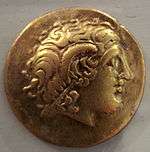Nantuates
The Nantuates or Nantuatae were an ancient people of modern-day Switzerland, whose territory extended into adjacent areas now in modern-day France.
At Roman contact, the Nantuates bordered on the Allobroges and in Julius Caesar's time were included within the limits of the Provincia. Caesar[1] at the close of the campaign of 57 BCE sent Servius Galba with some troops into the country of the Nantuates, Veragri and Seduni, who extend from the borders of the Allobroges, the Lacus Lemannus (modern Lake Geneva) and the river Rhone to the summits of the Alps. The position of the Seduni in the valley of the Rhone about Sion, and of the Veragri lower down at Martigny, being ascertained, the Nantuates were likely located in the Chablais, on the south side of Lake Geneva, a position which is conformable to Caesar's text. Strabo (iv.) who probably got his information from Caesar's work, speaks of the Veragri, Nantuatae, and the Leman lake; from which we might infer that the Nantuates were near the lake. An inscription in honor of Augustus, which according to Guichenon's testimony was found at Saint-Maurice-en-Valais, which is in the canton of Valais lower down than Martigny, contains the words Nantuates patrono; and if the inscription belongs to the spot where it is found, it is some evidence that the Nantuates were in the lower part of the Valais. But if the Nantuates were neighbors of the Allobroges, they must have extended westward along the south bank of the lake into the Chablais. The Chablais is that part of Savoy which lies along the Leman lake between the Arve and the Valais. It is not certain how far the Allobroges extended along the Leman lake east of Geneva, which town was in their territory. It has been observed that the word nanto- in the Celtic language signifies 'valley, stream, running water'; and it is said that in the dialect of Savoy, every little mountain stream is called Nant, and that there are many streams of this name. Nant is also a Welsh word for 'stream'.
Textual interpretations
There is another passage in Caesar, where the name Nantuates occurs in the common texts,[2] which has caused great difficulty. He says that the Rhenus (the Rhine River) rises in the country of the Lepontii who occupy the Alps, and that it flows by a long distance (longo spatio) through the country of the Nantuates, Helvetii, and others. Walckenaer affirms[3] that the best and the greater part of the MSS. of Caesar have "Vatuatium" not "Nantuates"; but this is not true. The readings in this passage are Nantuatium, Natuantium, Vatuantium, Mantuantium, and some other variants[4] Strabo[5] says that the Aetuatae (Αἰτουάται) inhabit the first part of the course of the Rhine, and that the sources of the river are in their country near Mount Adula. Casaubon changed Aetuatae into Nantuatae to make it agree with Caesar's text, and Cluverius changed it into Helvetii. Both changes are opposed to sound criticism. The name in Caesar's text is not certain, and in Strabo it may be wrong, but nothing is plainer than that these people, whatever is their name, are in the valley of the Rhine. Oberlin in his edition of Caesar has put the name Sarunetium in place of Nantuatium; but the Sarunetes of Pliny were in the valley of Sargans. Groskurd[6] has adopted the alteration Helvetii in his translation; and very injudiciously, for the Helvetii were not in the high Alps. Friedrich August Ukert[7] would also alter Strabo's Aetuatae into Nantuatae to fit the common text of Caesar; and he gives his explanation of the position of the Nantuatae, which is a very bad explanation. The Nantuates occur among the Alpine peoples who are mentioned in the Trophy of Augustus[8] and they are placed thus: Lepontii, Uberi, Nantuates, Seduni, Veragri, from which, if we can conclude anything, we may conclude that these Nantuates are the Nantuates of the Lower Valais.
References
 This article incorporates text from a publication now in the public domain: Smith, William, ed. (1854–1857). "article name needed". Dictionary of Greek and Roman Geography. London: John Murray.
This article incorporates text from a publication now in the public domain: Smith, William, ed. (1854–1857). "article name needed". Dictionary of Greek and Roman Geography. London: John Murray.
